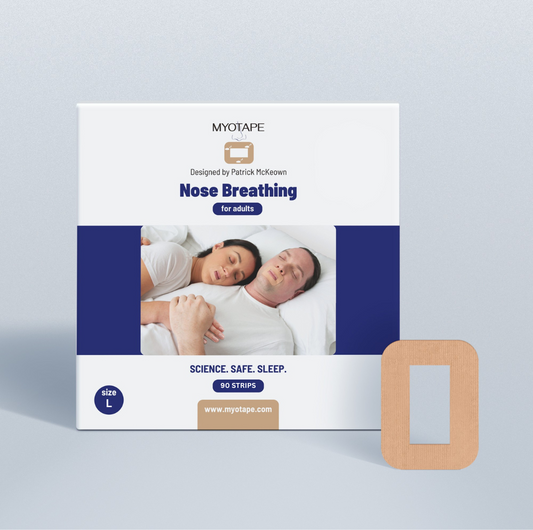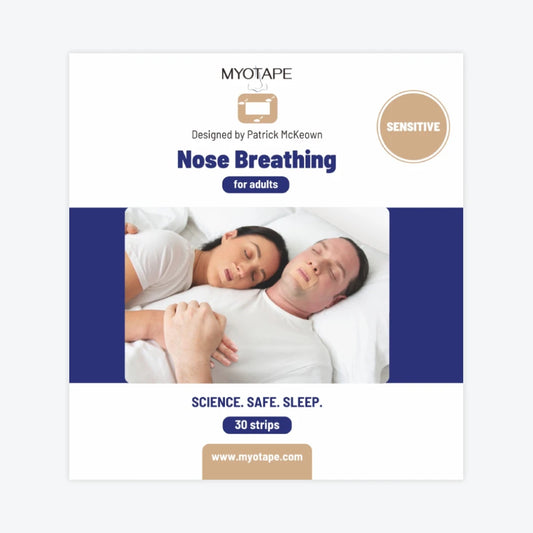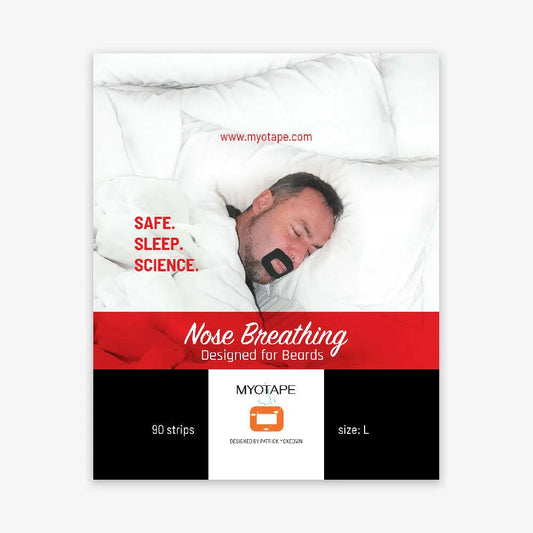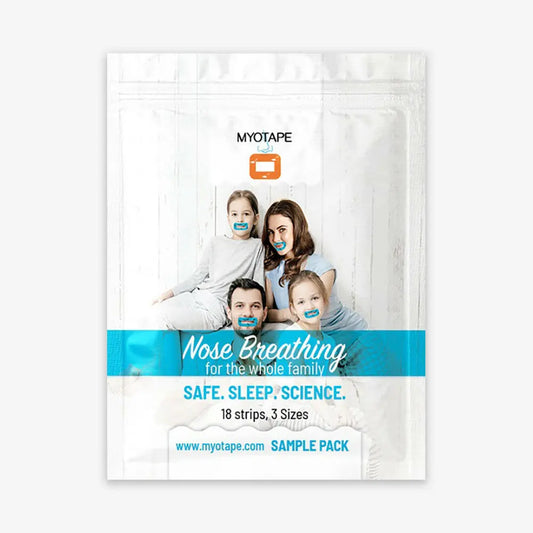Mouth taping is a technique that promotes nasal breathing by placing a special adhesive tape over your lips to keep your mouth closed while you sleep. This simple method can reduce snoring, enhance your sleep quality, and improve oral health, among many other benefits. As more people discover its benefits, mouth taping is becoming increasingly popular.
However, like any new habit, getting used to sleeping with mouth tape can come with its own set of challenges. Many individuals worry about the discomfort of having their mouth taped shut or fear they might not be able to breathe properly. These concerns are completely valid and can make mouth taping seem intimidating at first.
If you're curious about mouth taping but unsure about how to start, what to expect, or how to get used to sleeping with it, then you have come to the right place. Rest assured, this article is here to address your concerns and provide you with a step-by-step guide on how to get used to sleeping with mouth tape.
Why Consider Mouth Taping?
First off, why would anyone consider taping their mouth? The answer lies in the significant differences between mouth breathing and nasal breathing. Mouth breathing can lead to various health issues, including dry mouth, snoring, disrupted sleep, and even increased risk of respiratory infections.
In contrast, nasal breathing filters out dust, allergens, and other particles while also regulating the temperature and humidity of the air you inhale. This helps protect your lungs and improve oxygen uptake.
Proper breathing is essential for a good night's sleep. Mouth taping simply helps you breathe through your nose by keeping your mouth closed during sleep. This simple yet effective technique gently forces you to breathe through your nose, so you can gain the natural benefits of nasal breathing.
When your mouth is taped shut, it reminds you to maintain nasal breathing throughout the night, helping to prevent the common issues associated with mouth breathing. Mouth tapes can also train you to breather better i.e through your nose. Here are some of the benefits of mouth taping and potential risks or precautions you should know.
Benefits of Mouth Taping
- Reduced snoring: Nasal breathing can significantly reduce or eliminate snoring.
- Improved sleep quality: Better oxygen exchange leads to more restful sleep.
- Better oral health: Prevents dry mouth, reducing the risk of cavities and gum disease.
- Enhanced respiratory health: Filters and humidifies the air, reducing the risk of infections and allergies.
Potential Risks and Precautions
- Breathing difficulties: Not suitable if you have nasal congestion or other breathing issues.
- Skin irritation: Adhesive tape can cause irritation or allergic reactions.
- Claustrophobic feeling and discomfort: Most mouth tapes may make you feel uncomfortable or claustrophobic, especially if you have anxiety.
- Sleep disruption: Initial discomfort might disrupt sleep.
What to Know Before Considering Mouth Taping
Before you start mouth taping, ensuring it is safe and suitable for you is important. While mouth taping is generally safe for most people, certain health conditions and situations require extra caution as it can be dangerous for them. Read this detailed safety guidelines for mouth taping for more information.
First and foremost, if you have any health concerns, speak to your medical doctor before trying mouth taping. You need to determine if you have any form of sleep apnea or medical conditions that would make mouth taping unsafe.
This is especially crucial if you have long-term or serious medical conditions such as heart issues, anxiety or panic disorders, sleep apnea, or are prone to panic attacks. Additionally, if there is a risk of severe acid reflux or vomiting, medical supervision is necessary to avoid complications. Mouth taping is not recommended for children or adolescents.
Never use any tape not specifically designed for mouth taping. Using inappropriate tapes can lead to skin irritation or other issues. Always choose medical-grade, hypoallergenic tapes that are safe for skin contact.
Finally, most mouth tapes that completely cover the mouth could worsen sleep apnea because they do not allow for mouth puffing, which according to medical research is important for patients with obstructive sleep apnea.

How to Get Used to Sleeping with Mouth Tapes
Getting used to mouth taping is not easy, but possible. Here are the practical tips to help you.
Choose the right tape
The first step to becoming comfortable with mouth taping is to select the right mouth tape. Selecting the right type of tape is crucial for comfort and effectiveness. You must always go for a medical-grade, hypoallergenic tapes designed specifically for skin contact like MyoTape.
Note that most conventional mouth tapes that cover the mouth entirely could increase anxiety and worsen sleep apnea. However, MyoTape is different and better, which may make it a safe mouth tape for kids.
Also, before beginning mouth taping, test the tape on a small area of your skin, such as your forearm. Leave it on for a few hours to ensure you don't experience any irritation or allergic reaction.
If you have beards or facial hair, you can use a standard mouth tape for beards, which would not leave glue residue or hurt during removal. You should also read the guide for mouth taping with a beard. And learn how to remove a mouth tape safely
Tips for selecting the most comfortable and effective tape:
- Choose a mouth tape that is gentle on the skin and easy to remove.
- Ensure the tape has good adhesive properties but doesn't leave residue.
- Look for tapes that allow some degree of natural movement to avoid feeling too restricted like MyoTape. Compared to regular mouth tapes, MyoTape allows you to yawn, sneeze, talk and drink without removing the tape.
Practice wearing them during the day
Start by wearing the tape for short periods during the day. Begin with 10-to-15-minute sessions while you're relaxed, such as when reading a book or watching TV. This helps you get used to the sensation without the pressure of trying to sleep.
Gradually increase the duration to 30 minutes, then an hour, as you become more comfortable. Focus on ensuring you can breathe easily through your nose during these practice sessions.
This gradual progression helps your body and mind adapt to the new feeling, making it less likely to cause anxiety or discomfort at night. You can also put on the mouth tape like 30 minutes before bed to help you adjust to it.
Practicing during the day builds your confidence in using mouth tapes. By the time you're ready to use the tape at night, it will feel more familiar and less intimidating, making it easier for you to have a successful and restful sleep.
MyoTape is a great option because, unlike other mouth tapes, it stimulates the muscles around your mouth, training you to keep it shut and breathe nasally.
Prepare well before mouth taping
Before applying the tape, make sure your lips and the surrounding area are clean and dry. This is essential for the tape to stick properly and stay in place throughout the night.
You could use a gentle cleanser to wash your face, then pat the area dry with a clean towel. Ensuring your lips are free from oils and moisture also helps reduce the risk of skin irritation and makes the taping experience more comfortable.
It's crucial to have clear nasal passages to breathe comfortably through your nose while your mouth is taped. If you have any nasal congestion, use a saline spray or a nasal rinse to clear your airways.
Furthermore, practicing breathing exercises and nose unblocking exercises can help ensure your nasal passages are open and you can breathe through your nose easily.
This step helps prevent any breathing difficulties and ensures that you can maintain nasal breathing throughout the night, making the mouth taping process more effective and comfortable.
Apply the mouth tape correctly
Applying the tape correctly is crucial for ensuring both comfort and effectiveness. Use a mouth tape that is approximately the width of your mouth.
This size would generally suffice to keep your mouth shut without causing discomfort. Unlike other mouth tapes, MyoTape reduces the feelings of claustrophobia and is convenient.
Next, stretch the mouth tape and place it horizontally over the middle of your lips, making sure it goes over both the upper and lower lips. Positioning the tape in the center helps to keep your mouth securely closed while still allowing for some natural movement. This can make the experience less restrictive and more comfortable.
Finally, press gently to secure the tape in place. Make sure it adheres well to your skin, but avoid pressing too hard to prevent irritation. A well-applied tape should stay in place throughout the night, helping you maintain nasal breathing and enjoy a more restful sleep.
Monitor your progress
Monitoring your experiences with mouth taping at night can also help you get used to it. Take note of any changes in your sleep quality, reductions in snoring, or any issues you face. This will help you see your progress and make any necessary adjustments.
Look for signs that mouth taping is working, such as waking up feeling more rested, snoring less, or having a less dry mouth. These positive changes show that you're on the right track and that mouth taping is benefiting you.

How Long Would It Take to Get Used to Mouth Tape?
The time it takes to get used to mouth taping can vary from person to person. Generally, it may take a few nights to a couple of weeks for most individuals to become comfortable with the practice. Starting with short periods during the day and gradually increasing the duration at night can help ease the transition and make the process more comfortable.
How Long Should You Tape Your Mouth?
Once you are accustomed to mouth taping, you should aim to use it throughout the entire night. This means applying the tape before you go to bed and keeping it on until you wake up in the morning. Consistent use every night can help reinforce nasal breathing habits and maximize the benefits of mouth taping.
How to Get Mouth Tape to Stay On?
Prepare your skin properly before applying mouth tape. Clean your face thoroughly and apply a thin layer of lip balm, allowing it to absorb before patting off excess. This protects your lips while keeping surrounding skin dry for better adhesion.
When applying, stretch the tape slightly and press firmly against your skin for 5-10 seconds. This activates the adhesive and ensures proper contact. Consider vertical placement across the center of your lips rather than horizontal for better staying power. Use proper sleep tape like MyoTape for best results.
Only Choose MyoTape to Enjoy Mouth Taping
Getting used to mouth taping for sleep is not easy, but if you have the right mouth taping solution, it becomes a lot easier. MyoTape is the safest, most effective, and scientifically-proven mouth tape for sleeping. Also. it is a suitable mouth tape for CPAP users.
Internationally recognized breathing expert Patrick McKeown designed MyoTape based on medical research. MyoTape is a safe and innovative mouth tape that gently holds your lips together, training the muscles around your mouth to stay closed. It allows for emergency mouth opening, reducing the feeling of claustrophobia and discomfort. It is also hypoallergenic, gentle, and easy to remove.
You can check out our range of effective mouth taping products designed for everyone, including mouth tape for kids, adults, those with sensitive skin, and even those with facial hair. Visit our online shop today to find the perfect MyoTape solution for you and start your journey to quieter, more restful nights.








